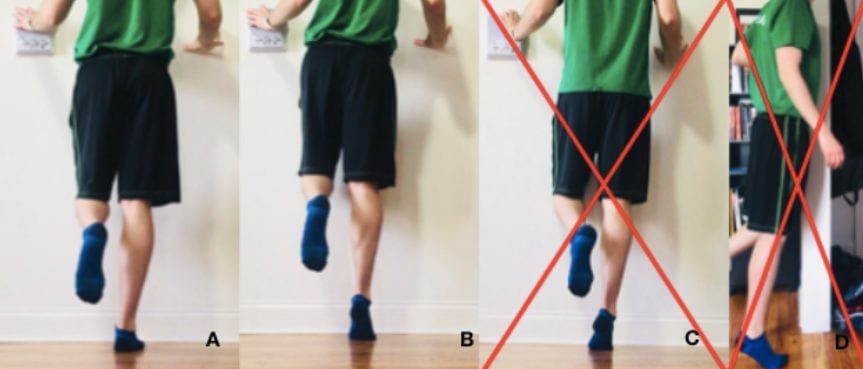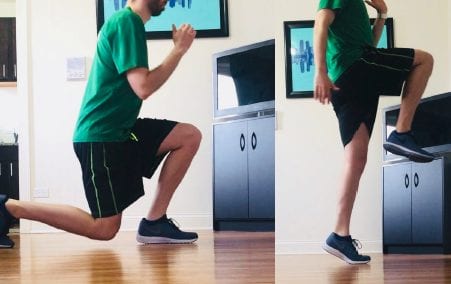Calf musculature (gastrocnemius and soleus) is responsible for the majority of propulsion and support during the stance phase of the gait cycle (Source 1). Additionally, injuries to the lower limb make up the bulk of all injuries in triathletes during both preseason and competition season (Source 2). Therefore, from both a performance and injury prevention standpoint, it is important that triathletes target this muscle group in their training. In endurance athletes, most injury is the result of training error. Usually, inadequate rest and training above the recommended workload lead to injury. To combat this, implementation of strength training is vital in increasing muscular capacity and training workload. The most effective method in targeting the calf muscles is the simple heel raise exercise. The exercise should be performed on a single leg, with hand support (A). Raise up slowly, pause at the top, and lower the heel down slowly (B). Push through the first two toes, do not roll to the outside of the foot (C) and do not rush the movement. It is also important that the body moves straight vertical and not forward (D).

A & B – Correct form. C- avoid rolling ankle laterally. D- Avoid Forward lean.
Studies suggest men should be able to perform at least 24 reps and women 21 reps. Begin with 3 sets of 10 and increase repetition as strength progresses. Add weight and a slight incline once you can perform 20 reps to further challenge the muscle. Adding variation to the heel raise is important as well as every step during your run will not be the exact same. Performing the exercise with the knee bent or on an incline challenges the muscles differently. A multi-joint exercise that targets the calf is the walking lunge to heel raise. This exercise is beneficial as it involves balance and includes the muscles acting on the hip and knee joints, which are also important for all phases of a triathlon.

Plyometrics are another way to build capacity of the lower leg muscles in preparation for the pounding a runner experiences in the final leg of a triathlon. An additional, often overlooked, benefit is increased achilles tendon stiffness with plyos. This is not to be confused with muscle stiffness. Why is tendon stiffness important? Muscles pull on tendons, which attach to bones. If a tendon become more elastic (less stiffness), it stretches and a portion of the muscular contraction does not transfer to the bone. The achilles tendon can experience loads up 6x greater than body weight with running and forgetting to train the achilles can result in greater risk for injury. Plyometric exercises to consider include (in increasingly challenging order to the calves): squat jumps in place, forward squat jumps, double leg ankle hops in place, side to side double leg ankle hops, single leg ankle hops in place, and side-to-side single leg ankle hops. John Linden, PT, DPT joined Illinois Bone and Joint in 2013 after graduating from Rosalind Franklin University of Medicine and Science. John practices out of the Glenview clinic and serves as the leader of the IBJI Foot & Ankle Special Interest Group. He believes that patients receiving therapy at IBJI have an advantage given the strong network and close clinician-physician relationships. His own treatment philosophy is geared towards empowering patients to take control of his or her situation.
*This content is for information only and is not intended to replace the diagnosis, treatment, or medical advice from your treating healthcare professionals. The content does not provide medical advice, does not constitute the practice of medicine or other healthcare professional services, and does not create a doctor-patient relationship. You should not rely on this information as a substitute, nor does it replace professional medical advice, diagnosis, or treatment. If you have concerns or questions, seek the advice of your healthcare professionals. If you think you may have a medical emergency, call your doctor or 911 immediately. Do not rely on electronic communications or communicate through this website for immediate, urgent medical needs. This website is not designed to facilitate medical emergencies. The use of the information is at the reader’s own risk. The links are provided for information and convenience only. We cannot accept responsibility for the sites linked or the information found here. A link does not imply an endorsement of a site.
